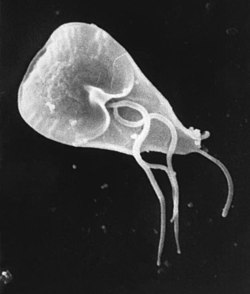Protozoa
Protozoa are microorganisms. They are single-celled heterotrophic eukaryotes, which eat bacteria and other food sources.
It is an old term, and the wider term protist is generally preferred today. However, 'protozoa' is often used for convenience, especially in junior education.[2] It is a convenient hold-all term, and most systems of taxonomy classify 'protozoa' into several different phyla.
The term is problematic because modern biochemical and genetic techniques show that it includes several quite different kinds of cells. They are found only in moist or aquatic habitats. Many protozoan species are symbionts, some are parasites, and some are predators of soil bacteria and algae. About 30,000 protozoan species are known. The study of protists is called "protistology".
Protozoa Media
Class Protozoa, order Infusoria, family Monades by Georg August Goldfuss, c. 1844
John Hogg's illustration of the Four Kingdoms of Nature, showing "Primigenal" as a greenish haze at the base of the Animals and Plants, 1860
Frederick Chapman's The foraminifera: an introduction to the study of the protozoa (1902)
Paramecium bursaria, is one example of a variety of freshwater ciliates that host endosymbiont chlorophyte algae from the genus Chlorella
Trophozoites of Entamoeba histolytica, a disease-causing parasite with engulfed red blood cells (dark circles)
Isotricha intestinalis, a commensal ciliate in the rumen of sheep
Related pages
References
- ↑ "Giardiasis (beaver fever) Fact Sheet". www.health.ny.gov.
- ↑ Gunter, Michelle 2008. Passing the North Carolina 8th grade end of grade test of science. American Book Company. ISBN 978-1-59807-186-3








